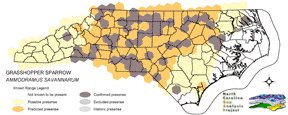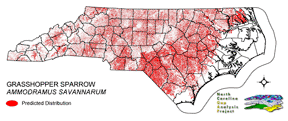
| Taxa: |
| Order: |
| Family: |
| Aves |
| Passeriformes |
| Emberizidae |
| NatureServe Global Rank: |
| NatureServe State (NC) Rank: |
| G5 |
| S4B,S1N |
| Federal Status: |
| NC State Status: |
| --- |
| --- |


| Land Unit |
| US Fish & Wildlife Service |
| US Forest Service |
| US National Park Service |
| US Department of Defense |
| NC State Parks |
| NC University System |
| NC Wildlife Res. Com. |
| NC Forest Service |
| NC Div. of Coastal Mgmt. |
| Local Governments |
| Non-Governmental Org. |
| Other Public Lands |
| Private Lands |
| GAP Status 1-2 |
| All Protected Lands |
| Statewide |
| Hectares |
| 1,137.24 |
| 14,268.60 |
| 41,340.87 |
| 3,240.54 |
| 4,064.31 |
| 379.26 |
| 21,522.42 |
| 2,789.64 |
| 206.73 |
| 777.96 |
| 1,871.19 |
| 2,375.91 |
| 3,578,000.67 |
| 14,987.25 |
| 92,222.55 |
| 3,671,975.34 |
| Acres |
| 2,810.18 |
| 35,258.47 |
| 102,155.49 |
| 8,007.55 |
| 10,043.13 |
| 937.17 |
| 53,183.05 |
| 7,166.89 |
| 510.84 |
| 1,922.38 |
| 4,623.81 |
| 5,871.00 |
| 8,841,430.48 |
| 37,307.84 |
| 228,160.39 |
| 9,073,920.45 |
| % of Dist. on |
| Prot. Lands |
| 1.2 % |
| 15.5 % |
| 44.7 % |
| 3.5 % |
| 4.4 % |
| 0.4 % |
| 22.4 % |
| 3.0 % |
| 0.2 % |
| 1.9 % |
| 1.9 % |
| 1.8 % |
| 0.0 % |
| 16.3 % |
| ----- |
| ----- |
| % of Dist. on |
| All Lands |
| < 0.1 % |
| 0.4 % |
| 1.1 % |
| < 0.1 % |
| 0.1 % |
| < 0.1 % |
| 0.6 % |
| < 0.1 % |
| < 0.1 % |
| < 0.1 % |
| < 0.1 % |
| < 0.1 % |
| 97.4 % |
| 0.4 % |
| ----- |
| ----- |
|
Breeds in the mountains south to Alleghany County (Simpson 1992) and across the piedmont (Potter et al. 1980). Short to medium grassy areas with forbs intermixed and little to no scattered shrubs. Also requires the presence of bare ground (Nicholson 1997). Likely areas include fields, pastures, airports (Potter et al. 1980), and reclaimed strip mining areas. Grasslands become unsuitable after 4-5 years without management (Nicholson 1997). Nest is built on the ground in a depression, beneath overhanging vegetation (Harrison 1975). Nests semi-colonially, in groups of 3-12 pairs (Ehrlich et al. 1988). NATURE SERVE GLOBAL HABITAT COMMENTS: Prairie, old fields, open grasslands, cultivated fields, savanna. Most common on managed grassland in the presence of clump-forming vegetation (Smith and Smith 1992). In New York, usually occurs in habitats managed for Henslow's sparrow (Smith and Smith 1992). Territories may include patches of bare ground and very short vegetation, posts, fence lines, and occasional trees (see Smith and Smith 1992). In tallgrass prairie habitats, large (>130 ha), regularly burned areas with no nearby wooded edges are most favorable (Johnson and Temple 1990). Most abundant in areas with woody shrubs and saw palmetto in Florida. Weedy fields and pastures with long grass in Puerto Rico (Raffaele 1983). Pastures and grassy edges of sugarcane fields in Jamaica (Lack 1976). In southeastern Arizona, avoided recently burned grassland habitats (Southwest. Nat. 37:73). Nests in depression on ground in site well concealed by vegetation. |
| Code | Name | Description | NC Natural Heritage Program Equivalent |
| 371 | Maritime Grasslands | Dune grass community consisting of sea oats and beach grasses. | Dune grass, Maritime dry grassland |
| 42 | Xeric Longleaf Pine | Sandhills including a range of longleaf pine density from predominantly wiregrass, scrub oak dominated to true longleaf pine woodland. This does not include mesic or saturated flatwood types. | Xeric Sandhill Scrub, Pine/Scrub Oak Sandhill, Coastal Fringe Sandhill |
| 226 | Piedmont Xeric Woodlands | Generally post and blackjack oak dominated woodlands. White ash and pignut hickory can be found in combination with Eastern red cedar on glades. | Xeric Hardpan Forest |
| 180 | Agricultural Crop Fields | Farm fields used for row crops. | No equivalent |
| 205 | Agricultural Pasture/Hay and Natural Herbaceous | Farm fields used for pasture grass or hay production, as well as old fields dominated by native and exotic grasses. | No equivalent |
|
Zink, R.M., and J.C. Avise. 1990. Patterns of mitochondrial DNA and allozyme evolution in the avian genus AMMODRAMUS. Syst. Zool. 39:148-161.
Johnson, D.H., and L.D. Igl. 1995. Contributions of the Conservation Reserve Program to populations of breeding birds in North Dakota. Wilson Bulletin 107:709-718. Ehrlich, P.R., D.S. Dobkin, and D. Wheye. 1992. Birds in jeopardy:the imperiled and extinct birds of the United States and Canada, including Hawaii and Puerto Rico. Stanford University Press, Stanford, California. 259 pp. Simpson MB Jr. 1992. Birds of the Blue Ridge Mountains. Chapel Hill and London: University of North Carolina Press. Peterjohn, B.G., J.R. Sauer, and W.A. Link. 1994. The 1992 and 1993 summary of the North American Breeding Bird Survey. Bird Populations 2:46-61. Smith, D.J., and C.R. Smith. 1992. Henslow's sparrow and grasshopper sparrow:a comparison of habitat use in Finger Lakes National Forest, New York. Bird Observer 20(4):187-194. Nicholson CP. 1997. Atlas of the breeding birds of Tennessee. Knoxville: University of Tennessee Press. Bent, A. C. 1968. Life histories of North American cardinals, grosbeaks, buntings, towhees, finches, sparrows, and allies. Bull. U.S. Nat. Mus. 237. Johnson, R.G., and S.A. Temple. 1990. Nest predation and brood parasitism of tallgrass prairie birds. Journal of Wildlife Management 54:106-111. Harrison, H.H. 1975. A field guide to bird's nests in the U.S. east of the Mississippi River. Houghton Mifflin Company, Boston, Massachusetts. 257 p. Lack, D. 1976. Island biology illustrated by the land birds of Jamaica. Studies in Ecology, Vol. 3. Univ. California Press, Berkeley. 445 pp. Harrison, C. 1978. A field guide to the nests, eggs and nestlings of North American birds. Collins, Cleveland, Ohio. Harrison, H.H. 1979. A field guide to western birds' nests. Houghton Mifflin Company, Boston. 279 pp. Potter, E. F., J. F. Parnell, and R. P. Teulings. 1980. Birds of the Carolinas. Univ. North Carolina Press, Chapel Hill. 408 pp. Terres, J.K. 1980. The Audubon Society encyclopedia of North American birds. Alfred A. Knopf, New York. American Ornithologists' Union (AOU), Committee on Classification and Nomenclature. 1983. Check-list of North American Birds. Sixth Edition. American Ornithologists' Union, Allen Press, Inc., Lawrence, Kansas. National Geographic Society (NGS). 1983. Field guide to the birds of North America. National Geographic Society, Washington, D.C. Raffaele, H.A. 1983. A guide to the birds of Puerto Rico and the Virgin Islands. Fondo Educativo Interamericano, San Juan, Puerto Rico. 255 pp. Hilty, S.L., and W.L. Brown. 1986. A guide to the birds of Colombia. Princeton University Press, Princeton, New Jersey. 836 pp. Ehrlich, P.R., D.S. Dobkin, and D. Wheye. 1988. The birder's handbook:a field guide to the natural history of North American birds. Simon and Shuster, Inc., New York. xxx + 785 pp. Ridgely, R.S., and G. Tudor. 1989. The birds of South America. Vol. 1. The Oscine passerines. Univ. Texas Press, Austin. 516 pp. Stiles, F.G., and A.F. Skutch. 1989. A guide to the birds of Costa Rica. Comstock Publ. Associates, Cornell University Press, Ithaca, New York. 511 pp. Droege, S., and J.R. Sauer. 1990. North American Breeding Bird Survey, annual summary, 1989. U.S. Fish and Wildlife Service, Biological Report 90(8). 22 pp. Carey, A. B., S. P. Horton, and B. L. Biswell. 1992. Northern spotted owls:influence of prey base and landscape character. Ecological Monographs 62:223-250. |
For more information please contact them at:
NC-GAP Analysis Project
Dept. of Zoology, NCSU
Campus Box 7617
Raleigh, NC 27695-7617
(919) 513-2853
www.basic.ncsu.edu/ncgap